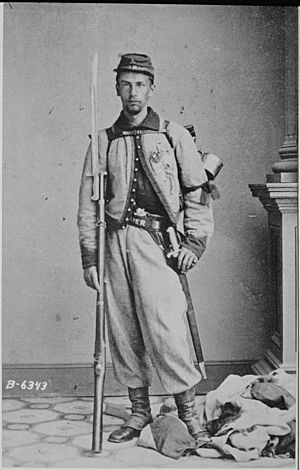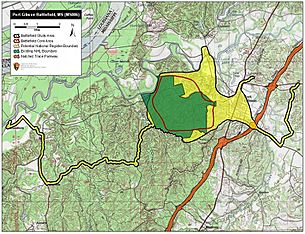Battle of Port Gibson facts for kids
Quick facts for kids Battle of Port Gibson |
|||||||
|---|---|---|---|---|---|---|---|
| Part of American Civil War | |||||||
 Zouave volunteer regiment Sgt. Francis E. Brownell, 11th N.Y. Regt, 1861 |
|||||||
|
|||||||
| Belligerents | |||||||
| Commanders and leaders | |||||||
| Ulysses S. Grant | John S. Bowen | ||||||
| Units involved | |||||||
| Army of the Tennessee | 4 brigades | ||||||
| Strength | |||||||
| 2 corps 23,000 | 8,000 | ||||||
| Casualties and losses | |||||||
| 861 | 787 | ||||||
The Battle of Port Gibson was an important fight during the American Civil War. It happened on May 1, 1863, near Port Gibson, Mississippi. In this battle, the Union forces fought against the Confederate forces. The Union Army was led by Ulysses S. Grant, who later became a famous general and president. The Union side won this battle. It was a key part of the larger Vicksburg Campaign, which aimed to take control of the city of Vicksburg.
Contents
Why Was the Battle of Port Gibson Fought?
Grant's Plan to Take Vicksburg
In the spring of 1863, General Grant started his plan to capture Vicksburg, Mississippi. Vicksburg was a very important city for the Confederates because it controlled a key part of the Mississippi River. Grant's army began moving south from Milliken's Bend, which was on the west side of the Mississippi River.
His main goal was to attack Grand Gulf. At the same time, another Union general, William Tecumseh Sherman, created a distraction. Sherman pretended to attack the Yazoo Bluffs near Vicksburg. This trick worked, and the Confederates sent only a small group of soldiers to deal with Sherman.
Crossing the Mississippi River
The Union navy tried to silence the Confederate cannons at Grand Gulf, but they couldn't. So, Grant decided to move his army further south. On April 30, he started crossing the Mississippi River at a place called Bruinsburg, Mississippi. This crossing was successful because Sherman's distraction kept most Confederate troops busy elsewhere.
The Confederates in the area had very few cavalry (soldiers on horseback). Their cavalry had been sent away to chase other Union forces. This meant the Confederates didn't know exactly where Grant's large army was landing. If they had known, they could have blocked Grant's path.
Confederate Preparations
The Confederate general in charge of the area was John S. Bowen. He moved his troops south from Grand Gulf to find out what Grant was doing. Bowen set up his soldiers near Port Gibson, ready to defend. More Confederate soldiers arrived later as backup.
The land around Port Gibson was very difficult to move through. There were tall hills and deep, narrow ravines filled with thick plants. This made it hard for Grant's much larger army to attack easily.
Union soldiers faced some delays because they didn't have enough food. But they still moved quickly towards Port Gibson. Just after midnight on May 1, Union soldiers met Confederate guards near the Shaifer House. There was some fighting and cannon fire until early morning. Both sides then waited for daylight to continue the battle.
How the Battle of Port Gibson Unfolded
Fighting on the Rodney Road
When daylight came, Union General Eugene A. Carr saw that a direct attack through the thick plants would not work. He planned a clever move: one group of his soldiers would push forward slowly, while another group would go around the side to attack the Confederates' left (left side).
More Union soldiers arrived and joined the attack. The Confederates were attacked on both sides and had to retreat. General McClernand, another Union commander, stopped to get his troops organized. He then continued chasing the Confederates. With about 20,000 Union soldiers, McClernand tried to push through the Confederate lines.
However, a surprise attack by Confederate soldiers from Missouri caused the Union right side to struggle. As the sun set, both sides were in a difficult situation along the Rodney Road, a few miles from Port Gibson.
Fighting on the Bruinsburg Road
On another road, the Bruinsburg Road, Union General Peter J. Osterhaus kept pressure on the Confederates with sharpshooters and cannons. Later in the afternoon, General James B. McPherson arrived with more Union troops. He quickly planned a way to go around the Confederate right side.
This new attack made the Confederate position impossible to hold. The Confederates had to retreat, leaving behind several hundred prisoners. With their escape route threatened, the Confederates began to pull back through Port Gibson towards the north.
What Happened After the Battle?
Confederate Retreat and Union Advance
On May 2, General Grant quickly outmaneuvered the Confederates. He sent General McPherson to cross the Bayou Pierre river upstream. Realizing that McPherson could cut off his escape, Confederate General Bowen ordered his strong defenses at Grand Gulf to be abandoned. They blew up their ammunition and destroyed their heavy cannons. Union gunboats then arrived and took Grand Gulf without a fight.
Grant understood what the explosion meant. He rode to Grand Gulf, where he could finally rest and clean up. He was happy to have captured Grand Gulf, which would become a main supply base for his army as they moved further inland.
Grant's Next Moves
Another Confederate general, William W. Loring, arrived too late to change Bowen's decision. The Confederates worked hard to get their forces across a narrow bridge. Union soldiers arrived just in time to save the bridge from being destroyed.
The Confederate army, which had fought bravely at Port Gibson, kept retreating until they reached fortifications near Warrenton, about ten miles away. They started improving these defenses, expecting Grant to follow them closely.
However, Grant had different plans. The roads on the west side of the Big Black River were open all the way to Jackson, the capital of Mississippi. Jackson was important because it had a critical railroad link to Vicksburg. Grant decided to move his army towards Jackson first, aiming to cut off Vicksburg's supplies.
Battlefield Preservation
Today, much of the Port Gibson battlefield is still private land. However, groups like the Civil War Trust (now part of the American Battlefield Trust) have worked to buy and protect about 644 acres (2.6 square kilometers) of this important historical site. This helps make sure that future generations can learn about this part of American history.
See also
 In Spanish: Batalla de Port Gibson para niños
In Spanish: Batalla de Port Gibson para niños



